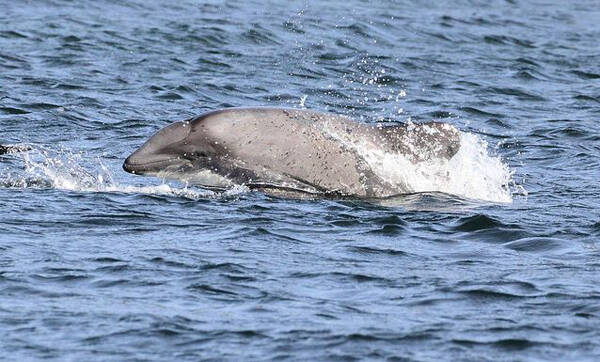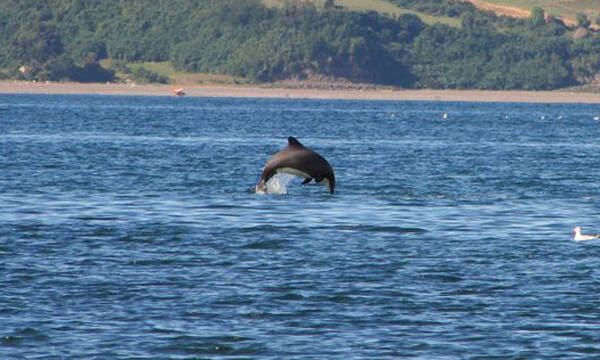Cephalorhynchus eutropia
IUCN
LCBasic Information
Scientific classification
- name:Cephalorhynchus eutropia
- Scientific Name:black dolphin, black dolphin, Chilean dolphin
- Outline:Cetacea
- Family:Delphinidae D.dolphin
Vital signs
- length:About 1.65 meters
- Weight:About 57kg
- lifetime:No verification information
Feature
After death, the body color will soon darken, so it is also called "black dolphin".
Distribution and Habitat
Origin (sea): Chile.
The distribution range extends from Valparaiso in the north (33°S, the northern limit of the distribution) to Navarino Island near Cape Horn (55°15'S, the southern limit of the distribution). In addition, it is also found in the Strait of Magellan and the Strait of Tierra del Fuego. Its distribution seems to be continuous, although the populations off Praia-Frailes, Valdivia, Arauco Bay, and Chiloé Island seem to be more dense. It is known to swim upstream into the Valdivia River and other rivers. It may also appear in the extreme south of Argentina.
Inhabits cold and shallow waters along the coast of Chile. Suitable water depth is 3-15 meters. There is no record of seasonal migration. It seems to prefer tidal waters. It often appears in fjords, bays and river entrances, but it can also be observed on fairly open coasts; it has never been seen offshore far from land.
Appearance
The beak is not obvious. The lips are white (some individuals have thicker white lips). The throat is white. The head is cone-shaped, with a gently sloping forehead. There is a light gray cap on the forehead. The pectoral fins are small and round, with a white area behind each pectoral fin. The dorsal fin is large and rounded, with a concave rear edge. The abdomen is white. The caudal fin is wide, with a concave rear edge and a prominent central notch; the end of the caudal fin is slightly rounded. Both sides of the caudal fin are dark gray. The dark gray body may appear brown, yellowish brown or gray at sea. The body color of the Chilean dwarf dolphin will soon deepen after death, so it is also called the "black dolphin".
There are 28-34/29-33 teeth on each side of the upper and lower jaws.
Size measurement: Adult length 1.65 meters (regardless of sex); adult weight 57 kg.
Distinctions: In the northern part of its range, it may be confused with the spiny-finned porp
Details
Chilean dwarf dolphin (scientific name: Cephalorhynchus eutropia) is also known as Chilean Dolphin and Black dolphin in foreign languages. There is no subspecies.

Little is known about the Chilean dwarf dolphin, but it is generally believed that this species of dolphin is cautious by nature; it rarely jumps into the waves. They have been recorded making slight undulating movements in the water, much like a swimming sea lion. They are often found in breakers and swells close to the coast. Those in the southern part of their range are wary of boats and difficult to approach, while those in the northern part of their range have been known to swim close to boats and may also engage in bow riding. Chilean dwarf dolphins have a cooperative behavior, with healthy individuals helping injured ones.
Chilean dwarf dolphins usually travel in small groups of 2-3; groups of 20-50 are rare, especially in the northern part of their range. They are often found with foraging seabirds. They feed primarily on small schooling fish, such as sardines, but also on squid and crustaceans. They prey on newly hatched salmon larvae at salmon hatcheries.
The mating season of Chilean dwarf dolphins begins in early winter and they reproduce in the spring of the following year. Females give birth to one calf every two years. Both sexes may reach sexual maturity at the age of 5 to 9 years. Females invest a lot of energy in raising their offspring during pregnancy and lactation. The calves will stay with their parents for a long time, during which time they will learn complex social behaviors, navigation, and foraging.

The only reliable abundance data for the Chilean dwarf dolphin population comes from a record of 60 individuals in 270 km2 of southern Chiloé Island, Chile (Heinrich 2006). The total population of Chilean dwarf dolphins is estimated to be less than 1,000 individuals. Fisheries illegally hunt Chilean dwarf dolphins for use as bait in their king crab fishing, but there is evidence that the emergence of alternative baits may have led to a decline in dolphin hunting.
Listed in Appendix II of the Convention on International Trade in Endangered Species of Wild Fauna and Flora (CITES).
Listed in China's "National Key Protected Wildlife List": National Second Class Protected Animal (effective December 10, 1988, Cetacean*Other Cetaceans)
Listed in the "IUCN Red List of Threatened Species": Near Threatened Species (NT), assessed in 2017.
Protect wild animals and stop eating game.
Maintaining ecological balance is everyone's responsibility!








